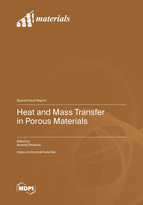Heat and Mass Transfer in Porous Materials
A special issue of Materials (ISSN 1996-1944). This special issue belongs to the section "Porous Materials".
Deadline for manuscript submissions: closed (20 March 2023) | Viewed by 17682
Special Issue Editor
Interests: heat and mass transfer in disperse systems; thermodynamics of nonequilibrium processes; quasi-stationary thermodynamic equilibrium; heat transfer in boiling liquid mixtures
Special Issues, Collections and Topics in MDPI journals
Special Issue Information
Dear Colleagues,
In this Special Issue entitled “Heat and Mass Transfer in Porous Materials”, achievements in experimental and computational studies of combined heat and mass transfer in porous media through the use of modern physical methods and models will be presented.
This problem is considered as one of the complex and significant fundamental courses of modern science, and has important applied relevance.
Original documents are requested for all scientific advances in the study of physicochemical processes in porous media.
For instance, this includes studies of heat and mass transfer processes in:
heat pipes (micro-heat, sorption and pulsating heat pipes with longitudinal grooves, micro- and nanoscale porous coatings, long heat pipes, vapourdynamic thermosyphons, etc.); in sorption cooling or heating systems; in mini-channels with porous nanocoating; in catalytic systems based on metals and metal-oxide porous materials, etc.
We also welcome studies on heat transfer enhancement in heat exchanger mini- and micro-channels, and on the practical use of heat pipes and thermosyphons.
Recent developments in the optimization of the platelet structure of materials used in various branches of technology for heat and mass transfer processes in porous spaces saturated with liquid or gas (evaporation, condensation, capillary transport, etc.) are of special interest.
Articles and reviews on the study of internal mechanisms of mass and energy transfer in porous media, including predictions and efficiency assessment of porous materials used in various branches of engineering and technology, would be an asset.
Prof. Dr. Anatoliy Pavlenko
Guest Editor
Manuscript Submission Information
Manuscripts should be submitted online at www.mdpi.com by registering and logging in to this website. Once you are registered, click here to go to the submission form. Manuscripts can be submitted until the deadline. All submissions that pass pre-check are peer-reviewed. Accepted papers will be published continuously in the journal (as soon as accepted) and will be listed together on the special issue website. Research articles, review articles as well as short communications are invited. For planned papers, a title and short abstract (about 100 words) can be sent to the Editorial Office for announcement on this website.
Submitted manuscripts should not have been published previously, nor be under consideration for publication elsewhere (except conference proceedings papers). All manuscripts are thoroughly refereed through a single-blind peer-review process. A guide for authors and other relevant information for submission of manuscripts is available on the Instructions for Authors page. Materials is an international peer-reviewed open access semimonthly journal published by MDPI.
Please visit the Instructions for Authors page before submitting a manuscript. The Article Processing Charge (APC) for publication in this open access journal is 2600 CHF (Swiss Francs). Submitted papers should be well formatted and use good English. Authors may use MDPI's English editing service prior to publication or during author revisions.
Keywords
- thermal conductivity
- mass transfer
- porous materials
- phase transitions
- platelet structure
Related Special Issue
- Heat and Mass Transfer in Porous Materials (Volume II) in Materials (2 articles)







